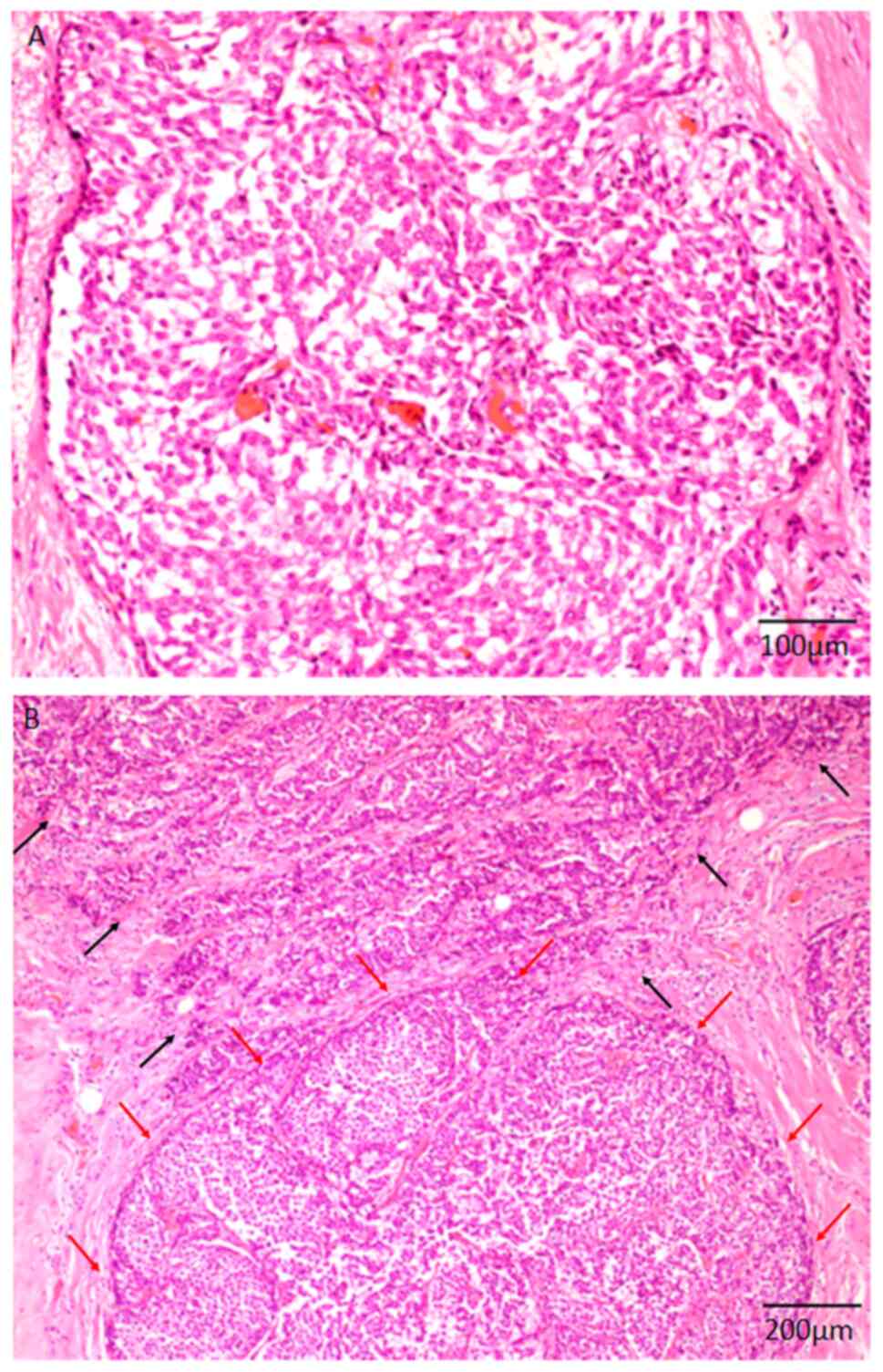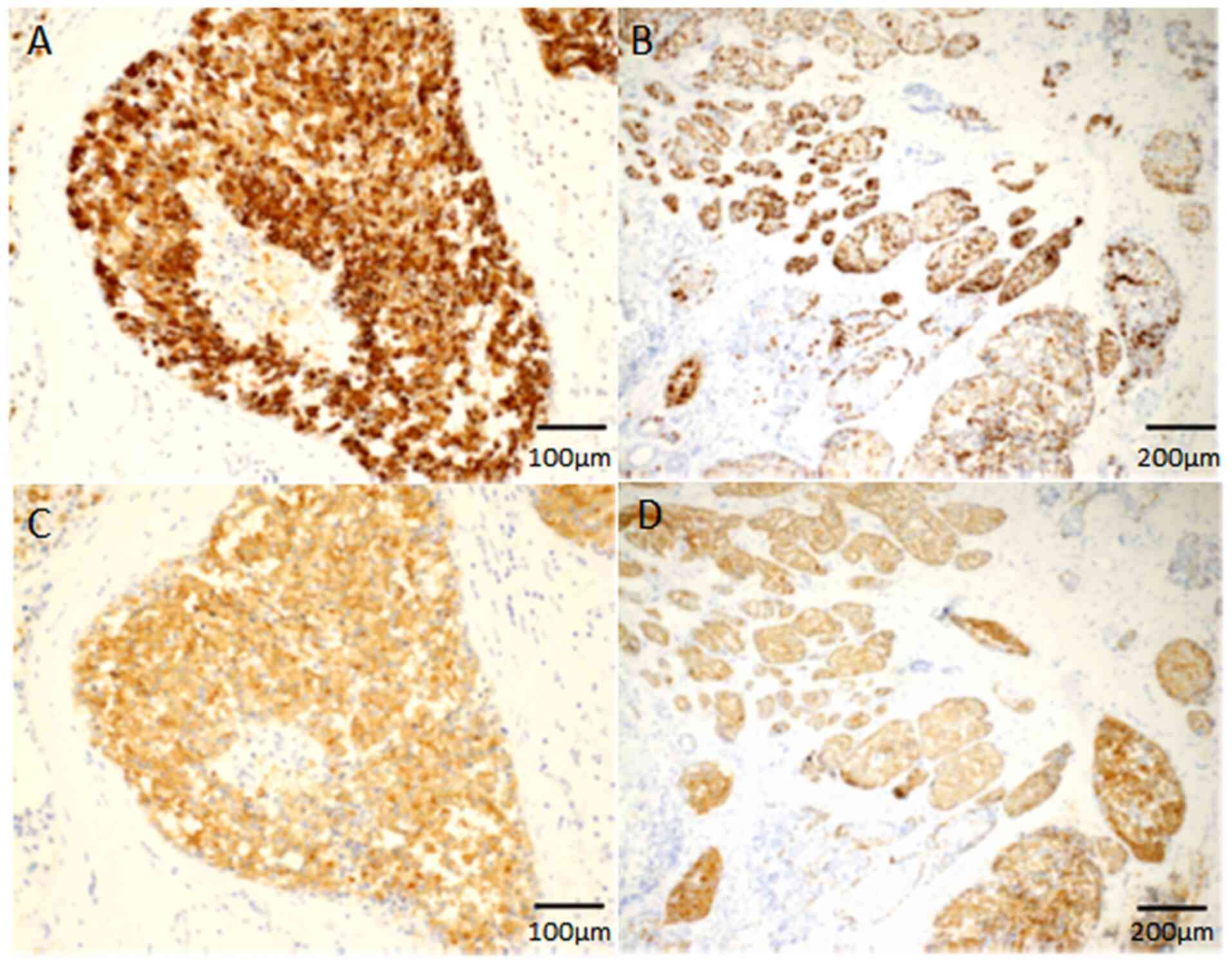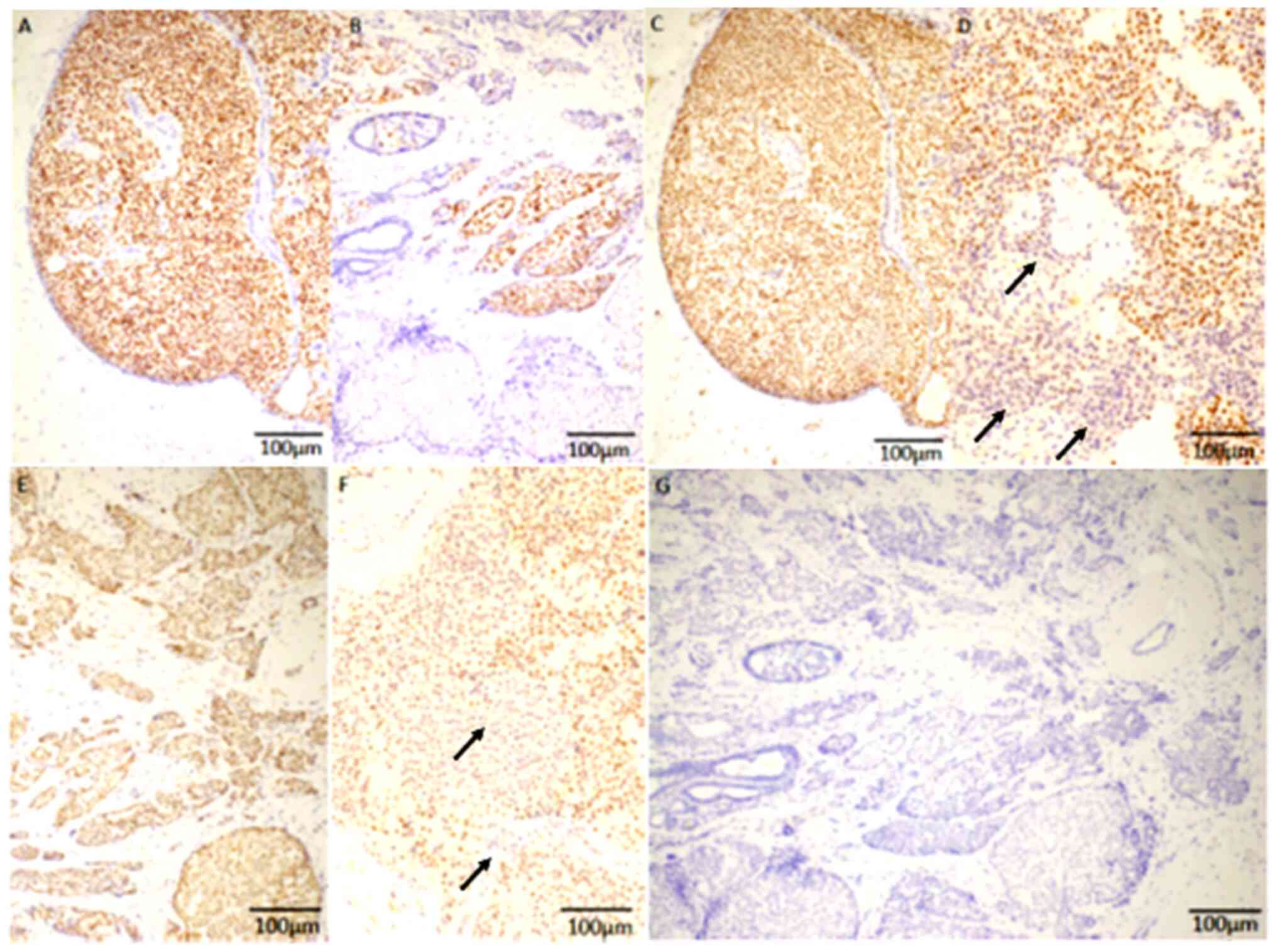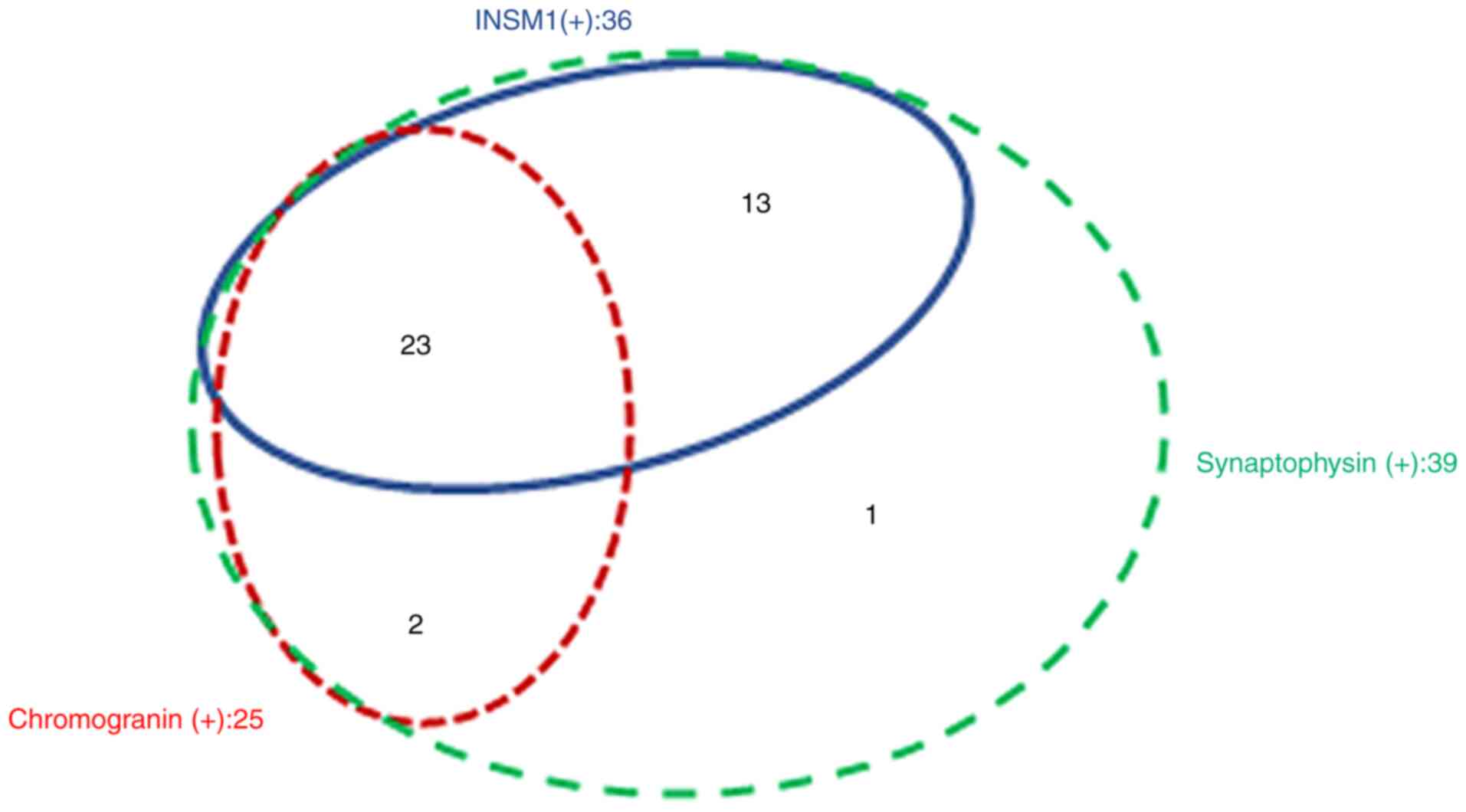|
1
|
Mac Grogan G, Collins LC, Lerwill M, Rakha
EA and Tan BY: Solid papillary carcinoma (in situ and invasive).
WHO Classification of Tumours. 5th edition. Breast Tumours IARC;
Lyon: pp. 63–65. 2019
|
|
2
|
Otsuki Y, Yamada M, Shimizu S, Suwa K,
Yoshida M, Tanioka F, Ogawa H, Nasuno H, Serizawa A and Kobayashi
H: Solid-papillary carcinoma of the breast: Clinicopathological
study of 20 cases. Pathol Int. 57:421–429. 2007. View Article : Google Scholar : PubMed/NCBI
|
|
3
|
Goto Y, De Silva MG, Toscani A, Prabhakar
BS, Notkins AL and Lan MS: A novel human insulinoma-associated
cDNA, IA-1, encodes a protein with ‘zinc-finger’ DNA-binding
motifs. J Biol Chem. 267:15252–15257. 1992. View Article : Google Scholar : PubMed/NCBI
|
|
4
|
Gierl MS, Karoulias N, Wende H, Strehle M
and Birchmeier C: The zinc-finger factor Insm1 (IA-1) is essential
for the development of pancreatic beta cells and intestinal
endocrine cells. Genes Dev. 20:2465–2478. 2006. View Article : Google Scholar : PubMed/NCBI
|
|
5
|
Lan MS and Breslin MB: Structure,
expression, and biological function of INSM1 transcription factor
in neuroendocrine differentiation. FASEB J. 23:2024–2033. 2009.
View Article : Google Scholar : PubMed/NCBI
|
|
6
|
Jia S, Wildner H and Birchmeier C: Insm1
controls the differentiation of pulmonary neuroendocrine cells by
repressing Hes1. Dev Biol. 408:90–98. 2015. View Article : Google Scholar : PubMed/NCBI
|
|
7
|
Rooper LM, Bishop JA and Westra WH: INSM1
is a sensitive and specific marker of neuroendocrine
differentiation in head and neck tumors. Am J Surg Pathol.
42:665–671. 2018. View Article : Google Scholar : PubMed/NCBI
|
|
8
|
Seok JY, Kang M, De Peralta-Venturina M
and Fan X: Diagnostic utility of INSM1 in medullary thyroid
carcinoma. Int J Surg Pathol. 29:615–626. 2021. View Article : Google Scholar : PubMed/NCBI
|
|
9
|
Dermawan JK and Mukhopadhyay S:
Insulinoma-associated protein 1 (INSM1) differentiates carcinoid
tumourlets of the lung from pulmonary meningothelial-like nodules.
Histopathology. 72:1067–1069. 2018. View Article : Google Scholar : PubMed/NCBI
|
|
10
|
Sakakibara R, Kobayashi M, Takahashi N,
Inamura K, Ninomiya H, Wakejima R, Kitazono S, Yanagitani N,
Horiike A, Ichinose J, et al: Insulinoma-associated Protein 1
(INSM1) is a better marker for the diagnosis and prognosis
estimation of small cell lung carcinoma than neuroendocrine
phenotype markers such as chromogranin A, synaptophysin, and CD56.
Am J Surg Pathol. 44:757–764. 2020. View Article : Google Scholar : PubMed/NCBI
|
|
11
|
Mukhopadhyay S, Dermawan JK, Lanigan CP
and Farver CF: Insulinoma-associated protein 1 (INSM1) is a
sensitive and highly specific marker of neuroendocrine
differentiation in primary lung neoplasms: An immunohistochemical
study of 345 cases, including 292 whole-tissue sections. Mod
Pathol. 32:100–109. 2019. View Article : Google Scholar : PubMed/NCBI
|
|
12
|
González I, Lu HC, Sninsky J, Yang C,
Bishnupuri K, Dieckgraefe B, Cao D and Chatterjee D:
Insulinoma-associated protein 1 expression in primary and
metastatic neuroendocrine neoplasms of the gastrointestinal and
pancreaticobiliary tracts. Histopathology. 75:568–577. 2019.
View Article : Google Scholar : PubMed/NCBI
|
|
13
|
Tanigawa M, Nakayama M, Taira T, Hattori
S, Mihara Y, Kondo R, Kusano H, Nakamura K, Abe Y, Ishida Y, et al:
Insulinoma-associated protein 1 (INSM1) is a useful marker for
pancreatic neuroendocrine tumor. Med Mol Morphol. 51:32–40. 2018.
View Article : Google Scholar : PubMed/NCBI
|
|
14
|
Kudo N, Takano J, Kudoh S, Arima N and Ito
T: INSM1 immunostaining in solid papillary carcinoma of the breast.
Pathol Int. 71:51–59. 2021. View Article : Google Scholar : PubMed/NCBI
|
|
15
|
Seijnhaeve E, Galant C and Van Bockstal
MR: Nuclear insulinoma-associated Protein 1 expression as a marker
of neuroendocrine differentiation in neoplasms of the breast. Int J
Surg Pathol. 29:496–502. 2021. View Article : Google Scholar : PubMed/NCBI
|
|
16
|
Metovic J, Castellano I, Marinelli E,
Osella-Abate S, Sapino A, Cassoni P and Papotti M: INSM1 expression
in breast neoplasms with neuroedocrine features. Endocr Pathol.
32:452–460. 2021. View Article : Google Scholar : PubMed/NCBI
|
|
17
|
Jiao Y, Shi C, Edil BH, de Wilde RF,
Klimstra DS, Maitra A, Schulick RD, Tang LH, Wolfgang CL, Choti MA,
et al: DAXX/ATRX, MEN1, and mTOR pathway genes are frequently
altered in pancreatic neuroendocrine tumors. Science.
331:1199–1203. 2011. View Article : Google Scholar : PubMed/NCBI
|
|
18
|
Marinoni I, Kurrer AS, Vassella E, Dettmer
M, Rudolph T, Banz V, Hunger F, Pasquinelli S, Speel EJ and Perren
A: Loss of DAXX and ATRX are associated with chromosome instability
and reduced survival of patients with pancreatic neuroendocrine
tumors. Gastroenterology. 146:453–460. e52014. View Article : Google Scholar : PubMed/NCBI
|
|
19
|
Wang F, Xu X, Ye Z, Qin Y, Yu X and Ji S:
Prognostic significance of altered ATRX/DAXX gene in pancreatic
neuroendocrine tumors: A meta-analysis. Front Endocrinol
(Lausanne). 12:6915572021. View Article : Google Scholar : PubMed/NCBI
|
|
20
|
Matsuo K, Taniguchi K, Hamamoto H, Inomata
Y, Komura K, Tanaka T, Lee SW and Uchiyama K: Delta-like canonical
Notch ligand 3 as a potential therapeutic target in malignancies: A
brief overview. Cancer Sci. 112:2984–2992. 2021. View Article : Google Scholar : PubMed/NCBI
|
|
21
|
Elston CW and Ellis IO: Pathological
prognostic factors in breast cancer. I. The value of histological
grade in breast cancer: Experience from a large study with
long-term follow-up. C.W. Elston & I O Ellis Histopathology
1991; 19.403-410. Histopathology. 41((3A)): 151–152; discussion
152–3. 2002. View Article : Google Scholar : PubMed/NCBI
|
|
22
|
Razvi H, Tsang JY, Poon IK, Chan SK,
Cheung SY, Shea KH and Tse GM: INSM1 is a novel prognostic
neuroendocrine marker for luminal B breast cancer. Pathology.
53:170–178. 2021. View Article : Google Scholar : PubMed/NCBI
|
|
23
|
Vranic S, Palazzo J, Sanati S, Florento E,
Contreras E, Xiu J, Swensen J and Gatalica Z: Potential novel
therapy targets in neuroendocrine carcinomas of the breast. Clin
Breast Cancer. 19:131–136. 2019. View Article : Google Scholar : PubMed/NCBI
|













